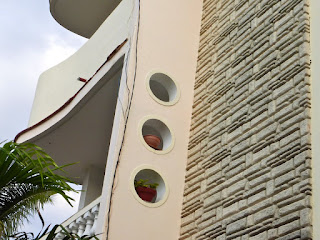When first in Havana I stayed in the 1875 Hotel Inglaterra, the building with the flag.
I walked into my room, admired the stained glass, opened the doors …
… and had Old Havana’s Parque Central at my feet.
It didn’t matter that the bathroom was, to be kind, eccentric. The atmosphere was redolent, for this young reporter was where, decades before, newspaper correspondents had put up while covering the Spanish-American War.
(March 19: It's announced that the Inglaterra is to become one of three Havana hotels to be operated by an American company. This will be the first time since 1959 that an American firm will have direct involvement in a Cuban tourism enterprise.)
Another time, I booked into the Plaza, opened in 1909. My room again had stained glass …
… and looked into an inner courtyard.
Opposite the Plaza, I took this picture of the 1930 Edificio Emilio Bacardi, one of Havana’s deco glories and city's tallest structure when completed.
I’ve learned from Cuban architecture …
In the 1940s, Batista ordered the construction of a massive TB sanatorium in the mountains east of Havana.
The style, a deco variant sometimes termed ‘modern monumental’ was favoured by the era’s dictators.
Nowadays, the structure, in a small town called Topes de Collantes, is a hotel with somewhat mixed reviews.
When privileged Eastern Bloc citizens were allowed to travel here, accommodation had to be built.
Cienfuegos’ 1976 Hotel Pasacaballo, where I stay this time, features a boxy-blocky, Soviet-influenced, resort design. Tropical brutalism?
By the way, many of those Eastern Bloc tourists defected on their way to - or flying back from - Cuba, when planes refuelled at Gander in Newfoundland.
Although I enjoy colonial and derivative architecture (despite all the columns, the Havana house above isn’t overly large) ...
… what I really like is modernism and into the Fifties. Above is Old Havana's 1951 Edificio de la Marina de Guerra (Navy Building), described as 'nautical deco'. Note the stylish crows nests (?) at the top.
Miramar, the once - and becoming again - posh neighbourhood in western Havana, is crammed with admirable residential design.
Look at the curves and postwar metalwork swirls …
… or at these wonderful seaside apartments and superb ornamentation.
Curvy balconies, portholes and circles within circles. Even a normally tasteless flamingo takes on a certain appeal.
Cuba’s long been known for art. I might complain about boxy, blocky hotels, but enjoy this cheerful stained glass in a resort near Trinidad.
On Havana’s outskirts is ‘Fusterlandia’, named for its creator José Fuster, an extraordinary Gaudi …
… and Picasso influenced oeuvre …
… although it’s not easy to make Hugo Chavez look appealing.
Where, other than touristy Old Havana, the world’s copyrighted brands have not arrived, there is art, too, in unstandardized signs. A hand-painted Cuban sign is unique.
We forget how drearily similar - and thus uninteresting - is mass-produced Western advertising.
I imagine this little bar as a refuge for neighbourhood men furtively seeking refreshment away from censorious womenfolk.
Click on the picture. No Century 21, RE/MAX or Coldwell Banker and their ubiquitous signs here.
A ‘death or country’ sign for the infamous CDRs (Committees for the Defence of the Revolution), which take busybody neighbourhood watch to a political extreme, may serve as a fading warning …
… but the Cienfuegos Propaganda Provincial printer looks quite jolly (if even older than Cuban cars).
Cuba makes one grateful for SD cards.


































































